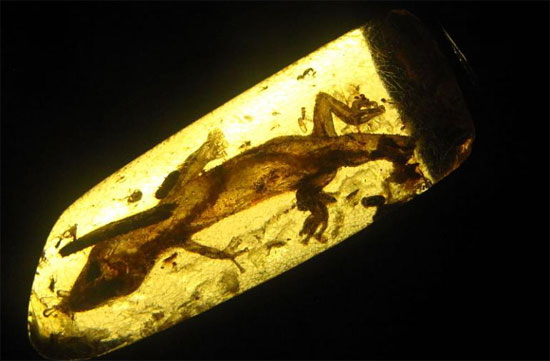Mexico: Lizard discovered 23 million years old
Scientists have discovered a 23 million-year-old lizard preserved intact in a sample of amber in Mexico.
Scientists have discovered a 23-million-year-old lizard belonging to a new species in Chiapas, Mexico, stuck in a piece of amber from primitive time with soft tissue still intact.
Mr. Francisco Riquelme of the National University of Mexico said that this "complete artifact still intact soft and skin tissue" about 4.6cm in length is currently on display at the Amber Museum in San Cristobal de las. Casas, Mexico.

The lizard stuck in the amber piece
The original study of World Science found that the lizard is a new species in 400 species of the Anolis strain. Known for its adaptability, the lizards of the Anolis strain can change color according to their surroundings.
With hundreds of species of lizards already discovered, these clustered scientists are the first reptiles to be sequenced.
Scientists used the age of the amber sample to determine the relative age of this ancient lizard. Gerardo Carbot, director of the Chiapas Ancient Biology Museum, said the amber sample where the lizard was locked was formed at least 23 million years ago.
Amber is translucent fossil-colored fossil resin and often contains specimens of plants or animals, but finding a complete vertebrate that is preserved intact in this amber lizard is invisible. The same rare.
The oldest animal found in amber is a 230 million-year-old tick (a blood-sucking insect, also called a tick) found in northeastern Italy. Science News reports that scientists analyzed 70,000 samples of amber until they found a piece of amber containing fossils of the tick.
Mr. David Grimaldi of the American Museum of Natural History said: 'Dinosaurs come and go, but the ticks are almost unchanged. Their body structure hundreds of millions of years ago is still similar to today's ticks. "
- Detecting sea lizard fossils 75 million years
- Discover the oldest lizard lord
- Discovered reptilian skull 70 million years
- Flying lizard eggs 120 million years in China
- Discovered many new lizards
- Discovered an ancient snake-headed lizard
- Discovered new lizards in Phu Yen
- Detecting a three-tailed lizard
- Discovered dinosaurs never known in Argentina
- 200 million year long sea fossil remains intact
- Found fossil lizard 120 million years old
- Human footprints date back to 25,000 years in Mexico
 Discovered an ancient centipede fossil 99 million years old
Discovered an ancient centipede fossil 99 million years old Discovered bat-like dinosaurs in China
Discovered bat-like dinosaurs in China Discovered a 200-year-old bronze cannon of the coast
Discovered a 200-year-old bronze cannon of the coast Discover 305 million-year-old spider fossils
Discover 305 million-year-old spider fossils